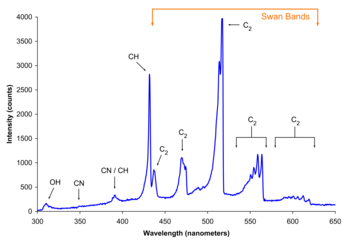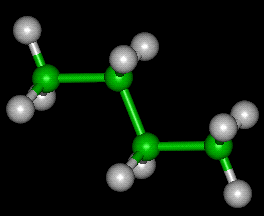|
The Butane Molecule |
Butane, also called n-butane, is the unbranched alkane with four carbon atoms, CH3CH2CH2CH3. Butane is also used as a collective term for n-butane together with its only other isomer, isobutane (also called methylpropane), CH(CH3)3.
Butanes are highly flammable, colorless, odorless, easily liquefied gases. The name butane was derived by back-formation from the name of butyric acid.
Reactions and uses
When oxygen is plentiful, butane burns to form carbon dioxide and water vapor; when oxygen is limited, carbon (soot) or carbon monoxide may also be formed.
- 2C4H10 + 13O2 ---> 8CO2 + 10H2O
n-Butane is the feedstock for DuPont's catalytic process for the preparation of maleic anhydride:
- CH3CH2CH2CH3 + 3.5O2 ---> C2H2(CO)2O + 4H2O
n-Butane, like all hydrocarbons, undergoes free radical chlorination providing both 1-chloro- and 2-chlorobutanes, as well as more highly chlorinated derivatives. The relative rates of the chlorination is partially explained by the differing bond dissociation energies, 425 and 411 kJ/mol for the two types of C-H bonds. The two central carbon atoms have the slightly weaker C-H bonds.

Butane gas is sold bottled as a fuel for cooking and camping. When blended with Propane and other hydrocarbons, it is referred to commercially as LPG. It is also used as a petrol component, as a feedstock for the production of base petrochemicals in steam cracking, as fuel for cigarette lighters and as a propellant in aerosol sprays.
Very pure forms of butane, especially isobutane, can be used as refrigerants and have largely replaced the ozone layer depleting halomethanes, for instance in household refrigerators and freezers. The flammability of butane is not a major issue because the amount of butane in an appliance is not enough to cause a combustible mix given the amount of air in a room. The system operating pressure for butane is lower than for the halomethanes, such as R-12, so direct conversion of R-12 systems to butane, such as in automotive air conditioning systems, will not function optimally.
Inhaling butane can cause drowsiness, narcosis, asphyxia; cardiac arrhythmia and frostbite, which can result in instant death from Asphyxiation, Acute toxicity and ventricular fibrillation. Butane is the most commonly misused volatile solvent in the UK, and was the cause of 52% of solvent related deaths in 2000.[1] By spraying butane directly into the throat, the jet of fluid can cool rapidly to –20 °C by expansion, causing prolonged laryngospasm.[2] "Sudden Sniffer's Death syndrome", first described by Bass in 1970,[3] is the most common single cause of solvent related death, resulting in 55% of known fatal cases.[2]
- Trends in death Associated with Abuse of Volatile Substances 1971-2004 Field-Smith M, Bland JM, Taylor JC, et al., Department of Public Health Sciences. London: St George’s Medical School
- Ramsey J, Anderson HR, Bloor K, et al. An introduction to the practice, prevalence and chemical toxicology of volatile substance abuse. Hum Toxicol 1989;8:261–9
- Bass M. Sudden sniffing death. JAMA 1970;212:2075–9
External links
- International Chemical Safety Card 0232
- NIOSH Pocket Guide to Chemical Hazards
- European Chemicals Bureau
- n-Butane Molecule of the Month
- Molview from bluerhinos.co.uk See Butane in 3D
- Computational Chemistry Wiki
- World LP Gas Association (WLPGA)
- LP Gas Association: Propane and Butane in the UK
- Global BioSciences In-Situ Bioremediation utilizing Butane
- Butane Viscosity as function of temperature and pressure
Some or all of this text has been obtained from Wikipedia, the free encyclopedia. All text is available under the terms of the GNU Free Documentation License (see Copyrights for details). Disclaimers. Wikipedia is powered by MediaWiki, an open source wiki engine.

